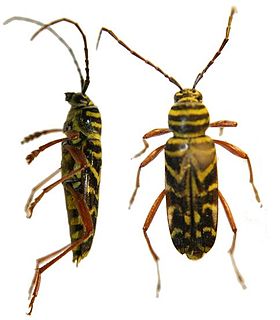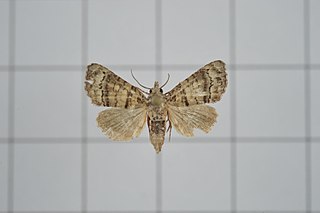Related Research Articles

Lychee is the sole member of the genus Litchi in the soapberry family, Sapindaceae.

The ash borer, or lilac borer, is a clearwing moth in the family Sesiidae. It is found throughout North America and can be a pest of ash and lilac.

Megacyllene robiniae, commonly known as the locust borer, is a species of longhorn beetle endemic to eastern North America. It is a serious pest of Robinia pseudoacacia, the black locust tree, with which it is sympatric.

Isotenes miserana is a species of moth of the family Tortricidae. It is found in the Northern Territory, Queensland, New South Wales and Victoria.

A pheromone trap is a type of insect trap that uses pheromones to lure insects. Sex pheromones and aggregating pheromones are the most common types used. A pheromone-impregnated lure, as the red rubber septa in the picture, is encased in a conventional trap such as a bottle trap, Delta trap, water-pan trap, or funnel trap. Pheromone traps are used both to count insect populations by sampling, and to trap pests such as clothes moths to destroy them.
Cryptophlebia ombrodelta, the litchi fruit moth or macadamia nut borer, is a moth of the family Tortricidae. The species was first described by Oswald Bertram Lower in 1898. It is native to India, Sri Lanka, Nepal, Indonesia, China, Taiwan, Vietnam, Thailand, western Malaysia, New Guinea, the Philippines, Japan, Guam, the Caroline Islands, Australia and has been introduced to Hawaii.

Cryptophlebia illepida is a species of moth in the family Tortricidae that is endemic to the islands of Kauaʻi, Oʻahu, Molokaʻi, Maui, Lānaʻi and Hawaiʻi. Common names include koa seedworm, klu tortricid, koa seed moth, litchi borer, litchi moth, macadamia nut borer and macadamia nut moth. It was first described by Arthur Gardiner Butler in 1882.
Adoxophyes privatana, the appleleaf-curling moth, is a moth of the family Tortricidae. The species was first described by Francis Walker in 1863. It is native to south-east Asia, where it has been recorded from Taiwan, Hong Kong, Hainan in China, Nepal, India, Sri-Lanka, Thailand, Vietnam, western Malaysia, Singapore, Sumatra, Java, Borneo, the Philippines and the Chagos Archipelago. It is an accidental introduction in Great Britain.
Thaumatotibia encarpa, the cacao husk borer, is a moth of the family Tortricidae. It is found in south-east Asia, including India, the Chagos Archipelago, Sri Lanka and Malaysia.

Phyllonorycter tristrigella is a moth of the family Gracillariidae. It is known from all of Europe, except the Iberian Peninsula and the Balkan Peninsula, east to the European part of Russia. It was also recorded from Japan, but this is a misidentification of Phyllonorycter laciniatae.
The cocoa pod borer is a moth of the family Gracillariidae. It is known from Saudi Arabia, China, India, Thailand, Brunei, Indonesia, Malaysia, Vietnam, Australia, New Britain, the Philippines, Samoa, the Solomon Islands, Sri Lanka, Taiwan and Vanuatu.
Conopomorpha litchiella is a moth of the family Gracillariidae. It is known from Australia, China (Fujian), India, Malaysia (Selangor), Nepal, Taiwan and Thailand.
Citripestis sagittiferella, the citrus fruit borer, is a species of snout moth in the genus Citripestis. It was described by Frederic Moore in 1891. It is found in Indonesia, Malaysia, Singapore and Thailand.

Prionus californicus, commonly known as the California root borer, is a species of insect in the longhorn beetle family (Cerambycidae). It is native to the American west where it is often a pest of orchard and vine crops.
Adoxophyes cyrtosema is a species of moth of the family Tortricidae. It is found in Tonga, on the New Hebrides and in China.
Indarbela quadrinotata, the bark-eating caterpillar, is a moth in the family Cossidae. It is found in India and Sri Lanka. It was described by Francis Walker in 1856.
Chilo auricilius, the gold-fringed rice stemborer or terai borer, is a moth in the family Crambidae. It was described by Gerald C. Dudgeon in 1905. It is found in India, Taiwan, Bhutan and Sri Lanka, as well as on Sulawesi, Borneo, Sangir Island and the Moluccas. The larvae bore into and feed on the stems of various grass family plants including sugarcane, rice and maize.

Chlumetia transversa, the mango shoot borer, is a moth of the family Euteliidae. The species was first described by Francis Walker in 1863. It is a widely distributed across Indo-Australian tropical countries far east to Solomon Islands.
Cosmopolites sordidus, commonly known as the banana root borer, banana borer, or banana weevil, is a species of weevil in the family Curculionidae. It is a pest of banana cultivation and has a cosmopolitan distribution, being found in all parts of the world in which bananas are grown. It is considered the most serious insect pest of bananas.
References
- ↑ "Global Taxonomic Database of Gracillariidae (Lepidoptera)" . Retrieved 12 September 2019.CS1 maint: discouraged parameter (link)
- ↑ "Fruit borer". www.padil.gov.au. Retrieved 12 September 2019.CS1 maint: discouraged parameter (link)